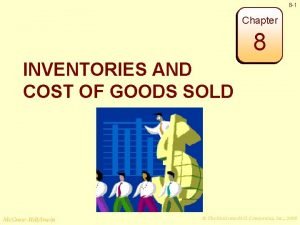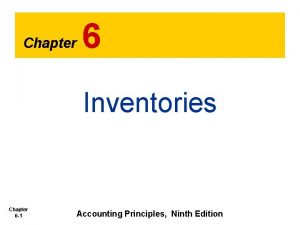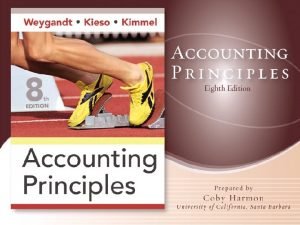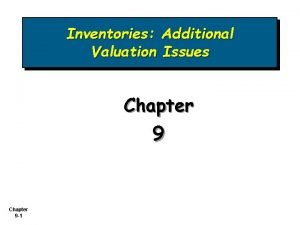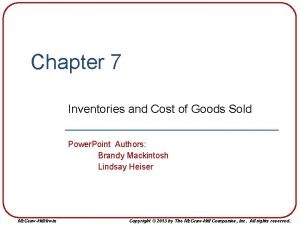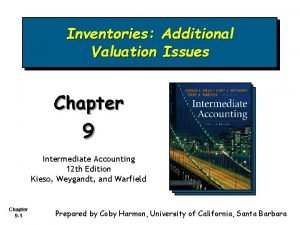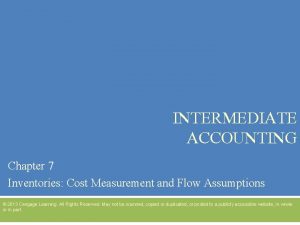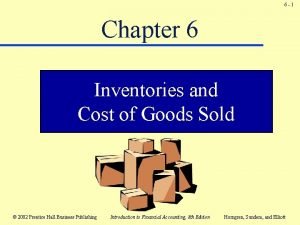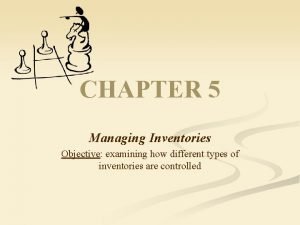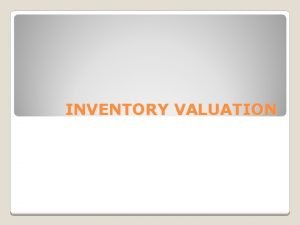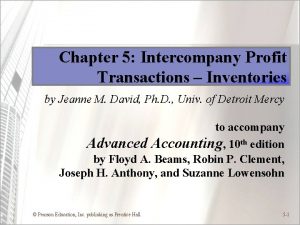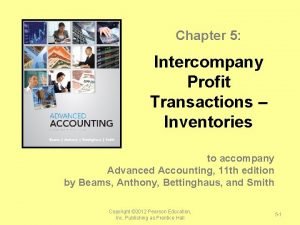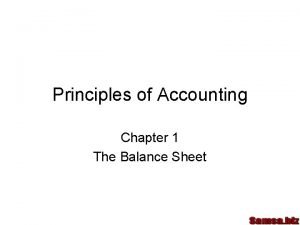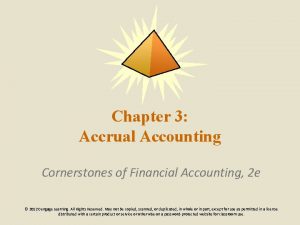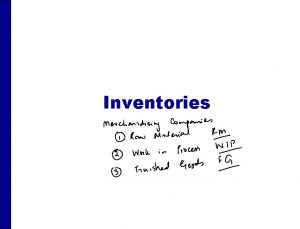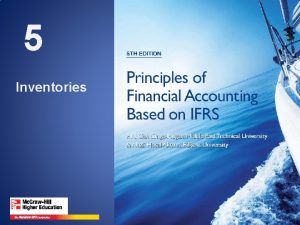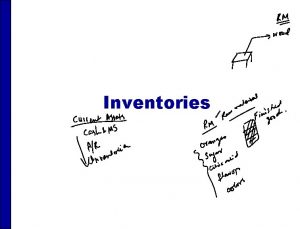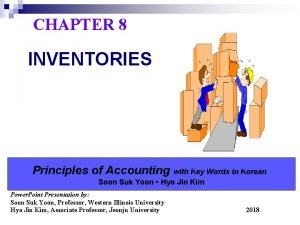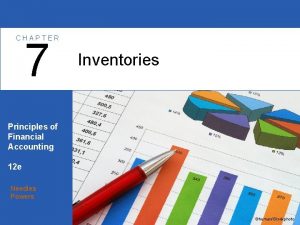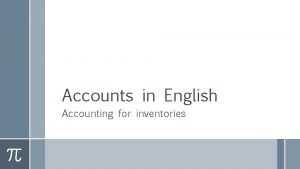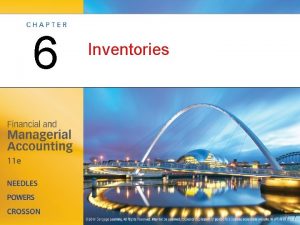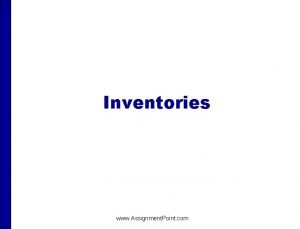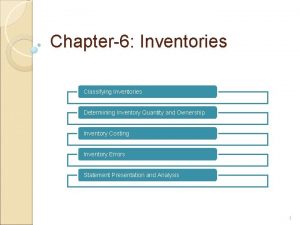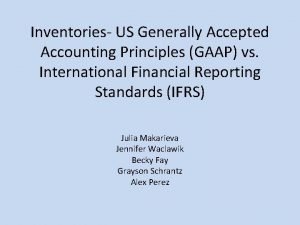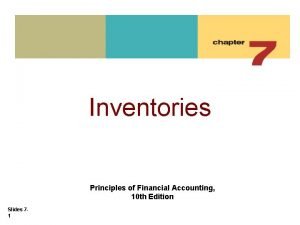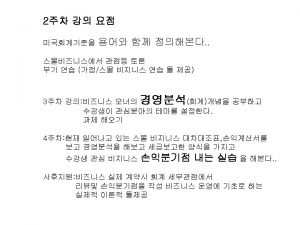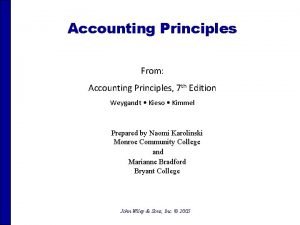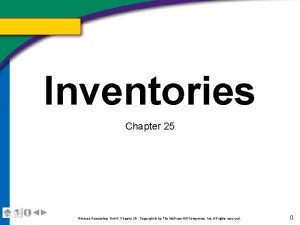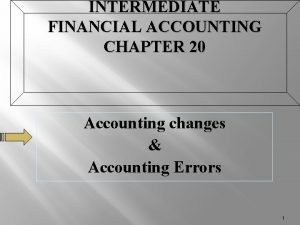Chapter 6 Inventories Chapter 6 1 Accounting Principles






















- Slides: 22

Chapter 6 Inventories Chapter 6 -1 Accounting Principles, Ninth Edition

Inventory Costing Unit costs can be applied to quantities on hand using the following costing methods: First-in, first-out (FIFO) Last-in, first-out (LIFO) Average-cost Chapter 6 -2 Cost Flow Assumptions SO 2 Explain the accounting for inventories and apply the inventory cost flow methods.

Inventory Costing – Cost Flow Assumptions “First-In-First-Out (FIFO)” Earliest goods purchased are first to be sold. Often parallels actual physical flow of merchandise. Generally good business practice to sell oldest units first. Chapter 6 -3 SO 2 Explain the accounting for inventories and apply the inventory cost flow methods.

FIFO Practice You made three purchases of merchandise in the following sequence: UNITS COST TOTAL l (1) 300 units at $6, (2) 400 300 X 6= $1800 units at $7, and (3) 200 units at 400 X 7= $2800 $8. l Assuming there are 360 units 200 X 8= $1600 on hand, compute the cost of 900 $6200 the ending inventory under the SOLD: 900 -360 =540 FIFO method. Chapter 6 -4 The ending inventory under FIFO consists of 200 units at $8 + 160 units at $7 for a total allocation of $2, 720 or ($1, 600 + $1, 120).

l l l FIFO- UR TURN In its first month of operations, Quirk Company made three purchases of UNITS merchandise in the following sequence: (1) 470 units at $6, (2) 325 units at $7, and (3) 180 units at $8. SOLD: Assuming there are 360 units on hand, compute the cost of the ending inventory under the FIFO Chapter method. 6 -5 COST TOTAL

ONE MORE FIFO l l l In its first month of operations, ABC made four purchases of merchandise in the following UNITS sequence: (1) 800 units at $6, (2) 300 units at $7, (3) 100 units at $8, (4) 200 units at 9. Assuming there are 200 units on hand, compute the cost of SOLD: the ending inventory under the FIFO method. Chapter 6 -6 COST TOTAL

Inventory Costing – Cost Flow Assumptions “Last-In-First-Out (LIFO)” Latest goods purchased are first to be sold. Seldom coincides with actual physical flow of merchandise. Exceptions include goods stored in piles, such as coal or hay. Chapter 6 -7 SO 2 Explain the accounting for inventories and apply the inventory cost flow methods.

The difference? ? l l l Chapter 6 -8 Net income is USUALLY highest under the FIFO method & USUALLY lowest under the LIFO method. By using LIFO, a company would appear to be making less money than it actually did, and therefore have to report less in taxes. 1 st inventory purchase $50 2 nd inventory purchase $75 SOLD ONE OF THEM FOR $100 NI: FIFO = $50. LIFO = $25

LIFO Practice- ADD THIS TO YOUR SPREADSHEET l l l You made three purchases of merchandise in the following sequence: (1) 300 units at $6, (2) 400 units at $7, and (3) 200 units at $8. Assuming there are 360 units on hand, compute the cost of the ending inventory under the LIFO method. UNITS 300 X 400 X COST 6= 7= 200 X 900 8= TOTAL $1800 $2800 $1600 $6200 SOLD: 900 -360 =540 The ending inventory under LIFO consists of 360 units at $6 + 60 units at $7 for a total allocation of $2, 220 or ($1, 800 + $420). Chapter 6 -9

LIFO UR TURN l l l In its first month of operations, Quirk Company made three purchases of merchandise in the following sequence: (1) 455 units at $6, (2) 657 units at $7, and (3) 173 units at $8. Assuming there are 360 units on hand, compute the cost of the ending inventory under the LIFO method. Chapter 6 -10 UNITS COST TOTAL

ONE MORE LIFO l l l In its first month of operations, ABC made four purchases of merchandise in the following sequence: (1) 800 units at $6, (2) 300 units at $7, (3) 100 units at $8, (4) 200 units at 9. Assuming there are 200 units on hand, compute the cost of the ending inventory under the LIFO method. Chapter 6 -11 UNITS COST TOTAL

FIFO & LIFO UR TURN Calculate the Total Cost Units Unit Cost Total Cost Inventory: January 1 10, 000 $90, 000 Purchases: June 18 6, 000 8. 00 48, 000 November 8 4, 000 7. 00 28, 000 TOTALS 20, 000 $166, 000 A physical inventory on December 31 shows 4, 500 units on hand. 1. Under the LIFO method, the 12/31 inventory is valued at: 2. Under the FIFO method, the 12/31 inventory is valued at: Chapter 6 -12

AVG Cost Practice l l l In its first month of operations, Quirk Company made three purchases of merchandise in the following sequence: (1) 300 units at $6, (2) 400 units at $7, and (3) 200 units at $8. Assuming there are 360 units on hand, compute the cost of the ending inventory under the AVG COST method. Average unit cost is computed as follows: 300 X $6 = $1, 800 400 X $7 = 2, 800 200 X $8 = 1, 600 900 $6, 200 AVG Price formula= TOTAL COST DIVIDED BY TOTAL UNITS. ($6, 200 ÷ 900 = $6. 89) The cost of the ending inventory is $2, 480 or (360 X $6. 89). Chapter 6 -13

AVG Cost UR TURN l l l In its first month of operations, Quirk Company made three purchases of merchandise in the following sequence: (1) 655 units at $6, (2) 392 units at $7, and (3) 286 units at $8. Assuming there are 360 units on hand, compute the cost of the ending inventory under the AVG COST method. UNITS Chapter 6 -14 COST TOTAL

REVIEW Inventory: Purchases: January 1 June 18 November 8 Units 6, 000 7, 500 4, 000 Unit Cost $9. 00 8. 00 7. 00 Total Cost 54, 000 60, 000 28, 000 A physical inventory on December 31 shows 2, 500 units on hand. 1. Under the FIFO method, the 12/31 inventory is valued at: 2. Under the LIFO method, the 12/31 inventory is valued at 3. Using the Average Cost Method, the 12/31 inventory is valued at: FIFO: UNITS SOLD: Chapter 6 -15 COST TOTAL LIFO: UNITS SOLD: COST TOTAL AVERAGE COST: UNITS COST TOTAL

OPEN CH 6 “Estimating Inventories” ON WEBSITE Gross Profit Method The gross profit method estimates the cost of ending inventory by applying a gross profit rate to net sales. Illustration 6 B-1 Chapter 6 -16 SO 8 Describe the two methods of estimating inventories.

Estimating Inventories Retail Inventory Method Company applies the cost-to-retail percentage to ending inventory at retail prices to determine inventory at cost. Illustration 6 B-3 Chapter 6 -17 SO 8 Describe the two methods of estimating inventories.

*BE 6 -11 At May 31, Creole Company has net sales of $330, 000 and cost of goods available for sale of $230, 000. Compute the estimated cost of the ending inventory, assuming the gross profit rate is 35%. Chapter 6 -18 SO 8 Describe the two methods of estimating inventories.

Estimating Inventories*BE 6 -12 On June 30, Fabre Fabrics has the following data pertaining to the retail inventory method: Goods available for sale: at cost $35, 000, at retail $50, 000; net sales $40, 000. Compute the estimated cost of the ending inventory using the retail inventory method. Chapter 6 -19 SO 8 Describe the two methods of estimating inventories.

Estimating Inventories Inventory turnover measures the number of times on average the inventory is sold during the period. Inventory Turnover = Cost of Goods Sold Average Inventory (beginning + ending)/ how many #s you added up Days in inventory measures the average number of days inventory is held. Days in Year (365) Days in = Inventory Turnover Chapter 6 -20 SO 6 Compute and interpret the inventory turnover ratio.

BE 6 -9 - Answers. At December 31, 2011, the following information was available for J. Graff Company: ending inventory $40, 000, beginning inventory $60, 000, cost of goods sold $270, 000, and sales revenue $380, 000. Calculate inventory turnover and days in inventory for J. Graff Company. Chapter 6 -21 Inventory Turnover = Days in Inventory = SO 6 Compute and interpret the inventory turnover ratio.

Chapter 6 -22
 Chapter 8 inventories and the cost of goods sold
Chapter 8 inventories and the cost of goods sold Chapter 6 inventories
Chapter 6 inventories Inventory in the balance sheet
Inventory in the balance sheet Chapter 9 inventories additional valuation issues
Chapter 9 inventories additional valuation issues Cost of good sold formula
Cost of good sold formula Lower of cost or market rule
Lower of cost or market rule The lifo conformity rule
The lifo conformity rule Chapter 6 inventories
Chapter 6 inventories Informal reading inventory strengths and weaknesses
Informal reading inventory strengths and weaknesses Recycled inventories in housekeeping
Recycled inventories in housekeeping Mnemjian inventories
Mnemjian inventories Juloidian inventories
Juloidian inventories Sos classification of inventory
Sos classification of inventory Intercompany journal entries
Intercompany journal entries Intercompany inventory transactions
Intercompany inventory transactions Smarter inventories
Smarter inventories Financial accounting chapter 1
Financial accounting chapter 1 Principles of accounting chapter 2
Principles of accounting chapter 2 Objectives of computerized accounting system
Objectives of computerized accounting system Going concern principle
Going concern principle Social responsibility accounting ppt
Social responsibility accounting ppt Pharmacy accounting principles
Pharmacy accounting principles Accrual accounting principles
Accrual accounting principles
